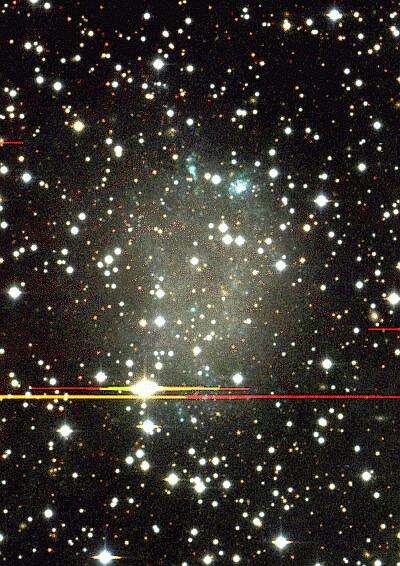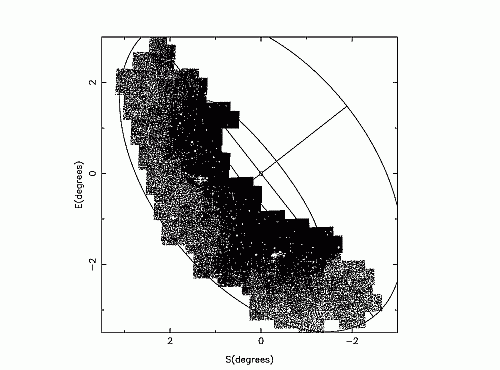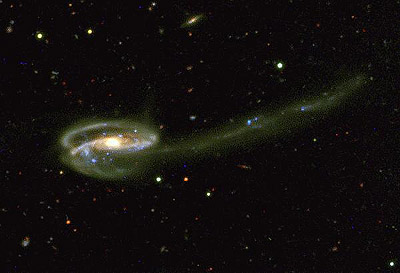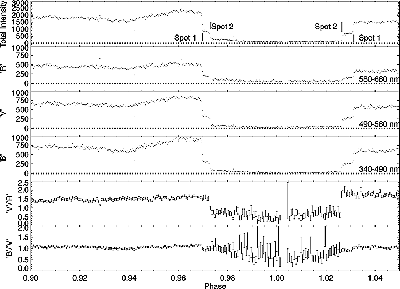|
FIRST
CLEAR SIGNATURE OF AN EXTENDED DARK MATTER HALO IN A DWARF SPHEROIDAL GALAXY
WHT+AF2/WYFFOS
The central velocity
dispersions of many Local Group dwarf spheroidal (dSph) galaxies are significantly
larger than expected for self-gravitating systems. Assuming virial equilibrium,
the implied mass-to-light (M/L) ratios reach as high
as  250, making the dSph galaxies among the most dark matter- dominated
systems in the universe. Given the apparent absence of dark matter in globular
clusters, dSph galaxies are also the smallest dark matter- dominated stellar
systems in the universe. As such, they have emerged as crucial testing
grounds for competing theories of dark matter.
250, making the dSph galaxies among the most dark matter- dominated
systems in the universe. Given the apparent absence of dark matter in globular
clusters, dSph galaxies are also the smallest dark matter- dominated stellar
systems in the universe. As such, they have emerged as crucial testing
grounds for competing theories of dark matter.
Despite their importance,dynamical
models of dSph galaxies to date have been very simple. Most
analyses have relied on the use of single-mass
isotropic King models, with their associated
assumptions that mass follows light and that
the stellar velocity distribution is isotropic.
Hitherto, the validity of such assumptions
has remained unchallenged because of the
small size of the data sets. When only
small numbers of radial velocities are available,
there is a well-known degeneracy between mass
and velocity anisotropy. An increase in the
line-of-sight velocity dispersion at large
radii may by due to either (1) the
presence of large amounts of mass at
large radii or (2) tangential anisotropy
in the velocity distribution. This degeneracy
could be broken by means of improved modelling and a larger data set
with many more stars in the outer parts.
Observations were conducted
from 2000 June 23 to 26 at the William Herschel Telescope using the AF2/WYFFOS
multifiber positioner and spectrograph. A total of 284 stars were observed,
spanning the magnitude range of V  17.0-19.8. Of these, 159 were Draco members (extending to 25')
with spectra of sufficient quality to be included in the dynamical analyses.
The median velocity uncertainty for these 159 stars was 1.9 km s-1.
These are the first observations to probe the outermost regions of a strongly
dark matter-dominated dSph galaxy.
17.0-19.8. Of these, 159 were Draco members (extending to 25')
with spectra of sufficient quality to be included in the dynamical analyses.
The median velocity uncertainty for these 159 stars was 1.9 km s-1.
These are the first observations to probe the outermost regions of a strongly
dark matter-dominated dSph galaxy.
From subsequent analysis,
astronomers found that the velocity dispersion profile is flat or slowly
rising at large radii, which provides the first c lear signature of an
extended dark matter halo in any dSph galaxy.
Further studies of this
cocoon, whose composition remains a mystery, promise to illuminate the
early history of our own Galaxy, which presumably built up from such
dark-matter quanta. This result also fits with the bottom-up view of
galaxy formation, in which the gravitational fields of big galaxies
shred smaller ones and assimilate their stars, gas, and dark matter.
Some references:
-
J.
T. Kleyna, et al., 2001, "First Clear Signature
of an Extended
Dark Matter Halo
in the Draco
Dwarf Spheroidal", ApJ
Letters, 563, 115.
- Kleyna, J T, 2003, "First Evidence for an Extended Dark Halo in the Draco Dwarf Spheroidal", ING Newsl, 7, 3.
-
R. Irion, 2001,
"Dark Dwarf Galaxy Gets Even Darker", Science News, 294,
2457.
A NEW NEARBY DWARF GALAXY
INT+WFC
The Wide Angle Survey,
one of the ING Wide Field Survey programmes, brings together a
diverse range of scientific topics, merging the observational programme
to increase scientific effectiveness.
As part of the Virgo
survey component some 25 square degrees of Virgo were obtained in the
B photometric band, and the pipeline processed object catalogues were
analysed. More than 500 Low Surface Brightness galaxies Btot<21 were discovered
by comparing the light profiles of the millions of objects in the
data frames with those of previously known template LSB galaxies.
Using this data astronomers
at Cambridge discovered a new nearby dwarf galaxy in the constellation of Cepheus. This LSB dwarf galaxy is a typical
example of previously unknown nearby galaxies, and it had been previously
overlooked because of its low surface brightness relative to the night
sky.
Most Local Group galaxies are satellites of the Milky
Way and Andromeda systems leaving only a few outliers to use as
probes of the dynamical evolution of the Local Group and for characterizing
the unperturbed evolution of nearby dwarf galaxies.
The luminosity
function in Virgo, when combined with the much flatter function found
in the field, will enable the efficiency of low mass galaxy formation
in differing environments to be investigated. First results are indicating
a strong environmental dependence, which would need to be taken
into consideration by Cold Dark Matter theories.

|
| Colour composite of Cepheus galaxy
created from 1200 second exposures in g', r' and i'-band images
taken in sub-arcsec conditions using the Wide Field Camera on the
INT [ JPEG
| TIFF ] |
Some references:
A GIANT STREAM OF METAL-RICH
STARS IN THE HALO OF THE GALAXY M31
INT +WFC
Within the
framework of hierarchical structure formation, large spiral galaxies
like the Milky Way or Andromeda arose from the merger of many small
galaxies and protogalaxies. Later in their evolution, spiral galaxies
become the dominant component in such mergers, cannibalizing smaller
systems that fall within their sphere of influence. The complete destruction
of the victim is usually progressive, and may take several orbits.
However, the stellar debris from the destroyed dwarf galaxy follows
a similar orbital trajectory to the progenitor, which is likely to
have started life far away from the place of its final demise, and
so the tidally disrupted matter tends to be deposited over a broad range
in distance from the larger galaxy. Over time, with the accumulation
of many such mergers, large galaxies develop an extensive stellar and
dark-matter 'halo', the latter being by far the most massive component
of the galaxy. Meanwhile, part of the (dissipative) gas component of
the smaller galaxies feeds the growth of the disk of the larger galaxy.
This is seen in numerical simulations of galaxy formation, which result
in galactic haloes comprising clumps of dark matter. If this prediction
is correct, then haloes should possess significant substructure—in contrast
to previous suggestions, which predict the dark and luminous components
of haloes to be distributed smoothly.
Andromeda or M31 galaxy
is our Galaxy's "big sister", twice as large but otherwise very similar.
It is the nearest large galaxy, lying only 2.2 million light-years away.
Astronomers have known for some years that our own Galaxy is a cannibal.
Its outer parts are threaded with tell-tale streams of stars from small
galaxies it has engulfed.
The first sensitive panoramic
wide field imaging
survey of M31 using the Wide Field Camera on the Isaac Newton Telescope
has unambiguously revealed the presence of a giant stellar stream
within M31's halo. The source of the stream is likely to be either,
or both, of the peculiar dwarf galaxies M32 and NGC205, close companions
of M31, which may have lost a substantial amount of stars, gas and dust
due to their tidal interactions with the massive host galaxy. The broad
agreement of the metallicity distribution of the stream stars with
these two dwarf satellites together with their alignment, physical
proximity, and distorted morphological appearance, point to a common
origin. The well-known disparity in properties between the Milky
Way and M31 stellar haloes would be understandable if the majority
of M31's stellar halo arose as relatively recent tidal debris from prolonged
bouts of aggressive tidal interaction with its two nearest neighbour
satellites. Together with recent observations of tidal debris in
the Milky Way halo, these results clearly demonstrate that the epoch
of galaxy building still continues, and that substructure in the form
of huge, recently-deposited tidal streams, could be a generic feature
of large galaxy haloes.

|
Surface density of RGB stars over the southeastern
halo of M31. The over-density of stars is seen as a stream extending
out of M31 close to, but distinct from, the minor axis. [ GIF | TIFF ]
|
The new survey was possible only because the digital
detector arrays such as the Wide Field Camera now cover fairly
large areas of sky. Even so, more than fifty long exposures had
to be pieced together to give a panorama of the halo on one side
of Andromeda.
Some references:
- CCI Annual Report 2001, 14.
- R.
Ibata, M. Irwin, G. Lewis, A. M. N. Ferguson and N. Tanvir,
2001, "A Giant Stream of Metal-Rich Stars in the Halo of the Galaxy
M31", Nature, 412, 49.
- M. Irwin et al., 2001, "The Andromeda
Stream: A Giant Trail of Tidal Stellar Debris in the Halo of M31",
ING Newsl., 5, 3.
- Irwin, M, Lewis,
G, Ibata, R, 2003, "Galactic Cannibals", Frontiers, No 17 Autum 2003.
- "Our Galaxy's "Sister" is a Cannibal",
AAO Press Release, 4 July 2001.
COMPLETELY DARK GALAXIES
INT+WFC
The universe could be harbouring numerous galaxies
that have no stars at all and are made entirely of dark matter. Astronomers
may ultimately discover that completely dark galaxies outnumber
the familiar kind populated by shining stars and gas, perhaps by
as many as 100 to 1. There is already a considerable amount of evidence
that bright galaxies contain large amounts of dark matter, often
ten times more than the mass of all their stars put together. There
must be extra mass that we do not see to account for the observed
movements of the stars under the influence of the gravity of the whole
galaxy. In some galaxies we see so few stars they are incapable of
holding themselves together as a galaxy. They would have long since
scattered through space without the gravity of unseen matter to keep
them together. But the question is: How do we look for these largely or
even completely dark galaxies?
It's a difficult challenge, and the best technique
will depend on the nature of the dark matter, which is still unknown.
If the dark matter is composed entirely of fundamental particles,
dark galaxies may act as gravitational lenses, distorting the appearance
of; distant galaxies that happen to lie behind them. If the dark
matter includes some brown dwarfs their infrared radiation may be
detectable. The same will be true if the galaxies contain any dead
stars, such as white dwarfs or black holes. If they are nearby, it might
be possible to detect these stellar remnants acting as gravitational
lenses on the light of individual stars in other galaxies beyond them.
Several lensing events in a small area of sky would suggest the presence
of a dark galaxy.
On place where a dark galaxy may exist has been identified
using images taken with the INT Wide Field Camera. A galaxy called
UGC 10214 has a stream of material flowing out of it, as if it is
interacting with another galaxy. But in this case, there is no other
galaxy or source of visible light present, hence the companion galaxy
may be completely dark.

|
From observations carried out as
part of the ING Wide-Field Survey astronomers have been able to identify
one place where a dark galaxy may exist. They noticed that a galaxy
called UGC 10214, shown above, has a stream of material flowing out
of it, as if it is interacting with another galaxy. In this case, the
stream of material is apparently flowing towards nothing.
[ JPEG | TIFF ]
|
Some references:
TIDAL STREAMS IN THE GALACTIC HALO
INT+WFC
A prediction
of standard cosmology is that dwarf protogalaxies
are the first to born as individual systems
in the universe. Afterward, many
of these merge to form larger galaxies such
as the Milky Way. The
way in which this process takes place
has consequences for the present-day structure
of the Milky Way. The significant issues are
how the merging efficiency compares with
the star formation efficiency in the protogalactic
fragments and how the fragment merging
and disruption compare with the age
of the Milky Way. If fragments are able
to form stars before merging, they will
collapse nondissipatively. If disruption
was not complete, Galactic precursors should
be visible today as dwarf galaxy satellites
or as stellar streams within the Galactic
halo.
The Sagittarius dwarf
galaxy, the closest Milky Way satellite
in an advanced state of tidal disruption,
provides a "living" test for tidal interaction
models and for galaxy formation theories. It was
soon apparent that its extent was larger than
at first assumed, and dynamical models
predict that the stream associated with the
galaxy should envelop the whole Milky Way in
an almost polar orbit.
Using the Wide Field
Camera on the Isaac Newton Telescope, astronomers detected a
very low density stellar system at 50 ±
10 kpc from the Galactic centre that could
be related to a merger process.

|
Color-magnitude diagrams
of the (panel a) control and (panels b and
c) target fields. Panel a
the distribution of the foreground
Milky Way stars. The overdense strip at (
provides B-R)  0.8, 22
0.8, 22  "V"
"V"  23.5 in panel b CMD is
interpreted as produced by a stellar system
at a distance of 51 ±
12 kpc from us, which could make it
part of the Sagittarius northern
stream or, alternatively, could be
the trace of a hitherto
unknown tidally disrupted dwarf galaxy. Squares
represent variable star candidates. Panel
c shows the CMD of the target field
with an old, low-metallicity (age:
12 Gyr; metallicity: 1/20 solar) isochrone from
the Padua library superposed. The isochrone MS
shape shows good agreement
with the hypothetical target field
MS. Also, the variable star candidates (squares)
fall in the predicted region
of the horizontal branch. [
JPEG | TIFF ]
23.5 in panel b CMD is
interpreted as produced by a stellar system
at a distance of 51 ±
12 kpc from us, which could make it
part of the Sagittarius northern
stream or, alternatively, could be
the trace of a hitherto
unknown tidally disrupted dwarf galaxy. Squares
represent variable star candidates. Panel
c shows the CMD of the target field
with an old, low-metallicity (age:
12 Gyr; metallicity: 1/20 solar) isochrone from
the Padua library superposed. The isochrone MS
shape shows good agreement
with the hypothetical target field
MS. Also, the variable star candidates (squares)
fall in the predicted region
of the horizontal branch. [
JPEG | TIFF ]
|
The found system is 60°
north and 46±12 kpc away from the centre
of the Sagittarius dwarf galaxy. If it
is really associated with this galaxy, it would
confirm predictions of dynamical interaction models indicating
that tidal debris from Sagittarius
could extend along a stream completely enveloping the
Milky Way in a polar orbit. However, the possibility that
it corresponds to a hitherto unknown
galaxy, also probably tidally stripped, cannot
be rejected.
Some references:
- "Galactic Cannibalism",
IAC Press Release, 9 March 2001.
- CCI Annual Report 2001, 16.
- D.
Martínez, A Aparicio, M. Angeles Gómez-Flechoso, R.
Carrera, 2001, "Tidal Streams in the Galactic Halo: Evidence for the
Sagittarius Northern Stream or Traces of a New Nearby Dwarf Galaxy",
ApJ Letters, 549, 199.
DISTANT GALAXIES ARE
IN THE RED
INT+CIRSI
The panoramic IR camera, CIRSI has been used to carry
out a large-scale survey of distant galaxies in the prime focus
of the INT. The main goal of the project was to study the Universe
when it was 7 billion years old, or around half its current age.
The recently completed infrared sky survey has detected
over 50,000 galaxies in a patch of sky covering roughly the area
of a full Moon. Although only one fifth of the data has been analysed
so far, already three times as many very red galaxies have been found
as was expected.
One possibility is that these galaxies have more old
stars in them than expected. Old stars tend to be large and relatively
cool -hence the red colour. A second possibility is that the galaxies
are very dusty, where scattering by dust particles causes objects
to appear red.
A second significant result is the discovery that these
red galaxies seem to clump together much more than galaxies in
the nearby Universe. One possible explanation is that these red
galaxies are merging with each other to form single more massive
galaxies.
This merging process would explain why the astronomers
are seeing more galaxies in the past than expected. If galaxies merge,
their total number will decrease to the present-day value.
Some references:
|



 250, making the dSph galaxies among the most dark matter- dominated
systems in the universe. Given the apparent absence of dark matter in globular
clusters, dSph galaxies are also the smallest dark matter- dominated stellar
systems in the universe. As such, they have emerged as crucial testing
grounds for competing theories of dark matter.
250, making the dSph galaxies among the most dark matter- dominated
systems in the universe. Given the apparent absence of dark matter in globular
clusters, dSph galaxies are also the smallest dark matter- dominated stellar
systems in the universe. As such, they have emerged as crucial testing
grounds for competing theories of dark matter.



 0.8, 22
0.8, 22  "V"
"V" 